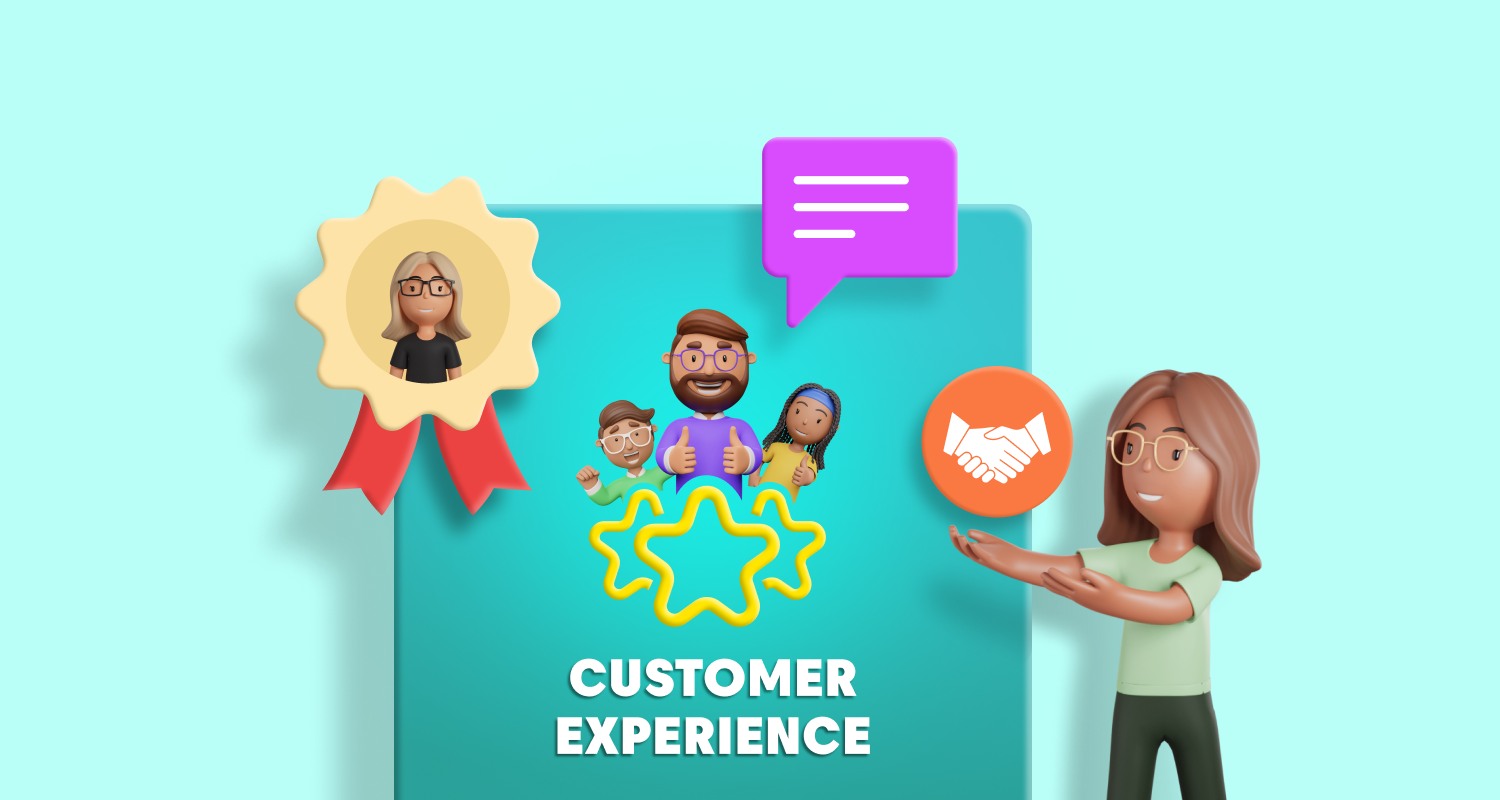The key to creating a customer-centric company is prioritizing customer needs and wants. Companies should focus on understanding customers’ expectations and creating a customer experience that meets them.
Companies should also strive to proactively anticipate customer needs and provide solutions before customers can inquire.
Companies should focus on building relationships with customers. This is achieved through customer loyalty programs and good communication. Companies should also focus on creating a customer-centric culture where online customer service is prioritized.
This blog will discuss the best strategies for improving your customers’ experiences.
Related articles
- Customer Experience Analytics: Important KPIs and Use Cases
- What is Customer Service Experience? Definition, Tips, and Examples
- Customer Service vs Customer Experience: Key Differences
- How to Create Customer Experience Strategy
- Top 10 Customer Experience Metrics & KPIs to Measure Success
- 9 Effective Customer Experience Optimization Strategies
- 7 Best Ways to Utilize AI for Customer Experience
What is customer experience?
Customer experience is the sum of all customer interactions with a company, from pre-purchase research to post-purchase follow-up. It is the result of a customer’s journey with a brand and can be influenced by customer service and marketing.
Why is customer experience important?
A good customer experience is essential because it is the key to success in a competitive market.
Companies that focus on creating client satisfaction are likelier to stand out from the competition and build a loyal customer base.
Moreover, it can directly impact a company’s bottom line, as satisfied customers are more likely to spend more money.
How to improve the customer experience
Customers’ experience can be enhanced, and the first step in doing so is to place the consumer at the core of your company plan.
To improve your customer service experience strategy, use the following suggestions.

1. Personalize the customer experience
Personalizing the customer experience boosts the customer journey by providing a more tailored and meaningful experience.
Salesforce reports that personalized engagement that reflects past interactions is considered important by 59% of consumers when it comes to attracting their business.
Companies can create a more individualized experience tailored to each customer’s needs and interests by considering customer preferences, purchase history, and other data points.
This helps to create more customer satisfaction, as customers feel that their individual needs are being considered.
Personalizing clients’ experiences can also help to increase customer loyalty and satisfaction, as customers feel that their needs are being met.
2. Provide self-service options
Not every customer issue requires individualized care, though.
Self-service options can improve the customer journey by:
- Reducing wait times
- Giving customers more control over their knowledge
- Allowing them to access information and services quickly and easily
Customer self-service options can also help reduce customer service costs, as customers can often find answers to their questions in a knowledge base or complete transactions in a portal without contacting customer service representatives. This supports 24/7 customer service by enabling customers to find solutions anytime.
For example, you can create a community forum where customers can discuss their issues and help each other.
This is a fantastic way to boost relationships and loyalty within your customer base.
3. Get your priorities right
A customer-centric approach ensures that the company culture revolves around meeting customer expectations efficiently.
This includes focusing on customer service, responding to customer inquiries quickly, and providing quality products and services.
Building this into your company culture and rhetoric from the start will help your employees stay in this mindset. It will come out in their customer service, creating client satisfaction and building trust and loyalty.
Additionally, it helps to ensure that customer feedback is considered and used to improve the customer journey.
This ensures that more fundamental issues are addressed quickly and efficiently and proves to your customers that you listen to them.
4. Constantly seek improvement
Businesses that want to enhance their customers’ experience should consider it a moving target.
The market is constantly changing, and so are customers’ expectations. To address customers’ shifting demands, build improvement methods into ongoing processes.
Your support agents and sales reps are your first point of contact with customers, so plan meetings to discuss what they’re hearing and present feedback results on a regular basis.
5. Appreciate your customers
Your business would be nothing without its clients, so show them some customer appreciation. Depending on your product or service, this can mean a thank you message after a purchase is made or a full welcome email with tips and resources.
When you resolve a customer’s issue, thank them for their patience. When they send your company feedback, not only have a thank you message pop up, but follow that feedback up if it involved a suggestion your company ends up implementing.
Explicitly teaching your support agents to keep their cool and always be polite goes a long way in demonstrating customer value.
Showing sympathy and gratitude to your clients for their support and loyalty helps to build a robust and lasting relationship with them.
6. Build an omnichannel experience
Building and utilizing an omnichannel inbox boosts your customers’ experiences by providing them with a unified and seamless experience across all channels.
No matter their choice of communication method, customers are provided with the same information and services when interacting with the company—be it via an application, live chat widget or the company’s website.
By providing a consistent experience, you are more likely to provide a positive experience.
Moreover, an omnichannel approach can help businesses increase customer satisfaction by offering alternative channels of communication that a customer may prefer.
7. Collect customer feedback
Businesses better understand consumers’ requirements, issues, and preferences when they ask them directly.
Gathering customer feedback may assist them in identifying areas for development, improving goods and services, and designing better client experiences.
Gathering client feedback offers insightful information about what people think and feel about your good or service.
Using brief questionnaires, may rapidly get client input and learn their requirements and preferences. Implementing their suggestions proves to your customers that you listen to them, which makes them feel heard and thus invested in your company.
Consumers usually have several alternatives, so offering a positive clients’ experience is essential to attracting and keeping them.
8. Train your employees
Equipping employees with the right skills and knowledge enables them to handle customer queries more effectively.
Training should focus not only on the technical aspects of the product or service but also on soft skills such as communication, empathy, and patience. This support also helps improve agent productivity.
Employees who feel supported by their employer are more likely to convey confidence, positivity, and attentiveness in their interactions with customers.
Enhancing the employment experience can significantly enhance the overall customer experience.
9. Be honest
Honesty is a key aspect of building trust with customers. Being transparent about your products, services, pricing, and policies helps customers make informed decisions.
In the event of bad customer service or an unforeseen issue, being upfront about it and offering a sincere apology can go a long way in maintaining customer trust.
Honest communication can also prevent misunderstandings and establish a reputation for reliability, which is crucial for long-term customer relationships.
Customers appreciate businesses that do not hide information or mislead them, and they are more likely to remain loyal to a brand that has demonstrated integrity.
10. Offer proactive customer service
Proactive customer service involves anticipating customer needs and addressing them before the customer has to ask for help.
This can include monitoring for common issues and reaching out to appropriate departments for solutions before more customers experience a problem.
This can come in the form of providing helpful resources such as FAQs or instructional content or sending reminders and updates about products or services.
By identifying and addressing customer pain points in advance, you can create a more frictionless customer experience that keeps customers coming back for more.
11. Provide an attractive user interface
The user interface (UI) is the point of interaction between the customer and the digital aspects of a business, such as websites, mobile apps, or software.
A well-designed UI that is intuitive, aesthetically pleasing, and easy to navigate can greatly enhance the customer experience.
It should allow customers to find what they are looking for with minimal effort and complete tasks without confusion.
If customers can effortlessly use the digital tools provided by a company, their overall experience with the brand is better.
12. Leverage AI and automation tools
Artificial intelligence and automation can enhance the customer experience. With AI-driven tools such as chatbots and virtual assistants, customers can receive instant responses to inquiries at any time of the day, without the need for human intervention.
Moreover, AI can analyze customer data to deliver tailored recommendations and services, making interactions feel more relevant and satisfying.
For instance, AI can track a customer’s purchase history and browsing behavior to suggest products they are more likely to buy, leading to a more curated shopping experience.
Automation streamlines repetitive and time-consuming tasks, which can free up human employees to focus on more complex customer service issues.
It also reduces the likelihood of human error, such as incorrect data entry, leading to improved accuracy in order processing and customer information management.
Benefits of prioritizing customer experience
A good customer service experience is important for the following reasons.
Improved customer retention
Customers who are satisfied with their experiences are more likely to remain loyal to a company or brand and continue to do business with them. This, in turn, leads to a rise in revenue and profits for the company.

Increased net promoter score
Prioritizing your customers’ satisfaction helps to build a better brand reputation.
When clients have a positive experience with a brand, they are more likely to recommend it to others, creating a positive outcome of free promotion and new customers.
Better reputation
By increasing brand loyalty among your customers, you are also gaining free promotion in the way of reviews.
When researching products to meet their needs, people rely heavily on reviews from other customers. Making your customer journey a great one will result in great reviews.
Ensure your products and services are listed on third-party platforms where customers can leave reviews potential customers will trust. Your company’s reputation will ride on these positive reviews.
Competitive advantage
Overall, focusing on clients’ experiences allows businesses to stand out from their competitors.
Create a uniquely excellent customer service experience, and customers will remember and return for it.
By focusing on the customer journey, companies can gain insight into customer needs and preferences that can be used to develop new goods and services that better appeal to customers.
This way, firms can stay ahead of their competitors and increase their profits.

Examples of good customer service experiences
Here are some examples of brands that consistently deliver good customer experiences.
Starbucks

Starbucks crafts a positive customer experience by blending a friendly atmosphere with convenience. They prioritize convenience with mobile ordering and drive-throughs while offering comfortable spaces to relax or work.
By combining friendly service, customization, and efficiency, Starbucks creates a customer experience that keeps clients coming back for more.
Southwest Airlines

Known for its customer-friendly policies, like free checked bags and no change fees, Southwest Airlines creates a positive experience with less hassle and a commitment to on-time flights.
Ritz-Carlton

Ritz-Carlton, the luxury hotel chain, is famous for its “empowerment” policy, where employees can spend up to $2,000 to resolve customer issues without having to seek an approval from a manager.
This allows staff to address problems quickly and generously, leaving a positive impression on guests.
Warby Parker

Warby Parker excels at customer experience by blending convenience and human touch. The eyewear company’s innovative Home Try-On program lets you pick glasses online and try them on at home, while their stores offer friendly staff and access to your online order history.
This focus on both digital ease and personalized interactions, along with their mission-driven approach, creates a shopping experience that feels frictionless.
Disney

Disney excels at customer experience by creating a seamless and immersive world. From highly trained cast members focused on guest happiness to detailed park upkeep, Disney strives to exceed expectations.
They leverage technology for convenience, prioritize emotional connections with characters and stories, and actively seek guest feedback to refine the magical experience.
Elevate your customer experience with BoldDesk
In summary, delivering good customer experiences requires ongoing effort. However, this is effort well spent.
One way to make the process easier is through a help desk like BoldDesk.
Try the BoldDesk free trial to see how it can streamline your support system and thus raise your client satisfaction levels. Feel free to contact the BoldDesk support team if you have any questions. For more information in general, please set up a live demo to get a clearer idea of how BoldDesk works and how it can be tailored to your company’s needs.



 Email Ticketing System
Email Ticketing System




